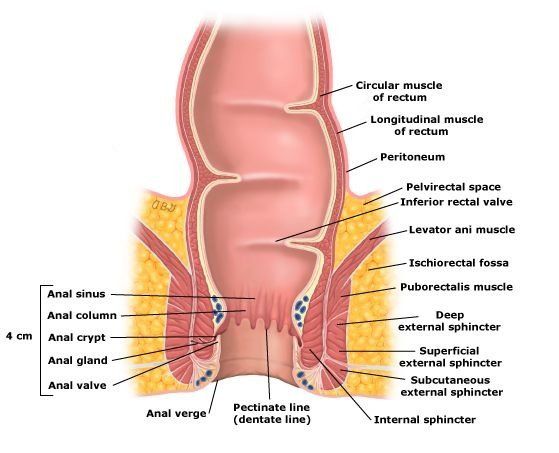Anorectal Disorders
Hemorrhoids
Haemorrhoids are an abnormal swelling or enlargement of the anal vascular cushions. Hemorrhoids are an extremely common condition, affecting approximately 10 million persons per year. Hemorrhoids represent normal, submucosal, venous structures in the lower rectum and anal canal that may be internal or external depending on their relationship to the dentate line: internal hemorrhoids are located above the dentate line, and external hemorrhoids originate below the dentate line.
Haemorrhoids are classified according to their size:
- 1st Degree - Remain in the rectum
- 2nd Degree - Prolapse through the anus on defecation but spontaneously reduce
- 3rd Degree - Prolapse through the anus on defecation but require digital reduction
- 4th Degree - Remain persistently prolapsed
The main risk factors for the development of haemorrhoids are excessive straining (from chronic constipation), increasing age, and raised intra-abdominal pressure (such as pregnancy, chronic cough, or ascites).
Other less common risk factors include pelvic or abdominal masses, family history, cardiac failure, or portal hypertension.
Anal Fissure
An anal fissure is a tear in the mucosal lining of the anal canal, most commonly due to trauma from defecation of hard stool. It can be classified according to its duration:
- Acute – present for <6 weeks
- Chronic – present for >6 weeks
Anal fissures can also be categorised by whether they are primary (no underlying disease) or secondary (underlying disease e.g inflammatory bowel disease).
Anal fissures are usually caused by inflammation or trauma to the anal canal. The major risk factors include:
- Constipation
- Dehydration
- Inflammatory bowel disease
- Chronic diarrhoea
Pilonidal Sinus Disease
Pilonidal sinus disease is a disease of the inter-gluteal region, characterised by the formation of a sinus in the cleft of the buttocks. It most commonly affects males aged 16-30 years .
Rectal Prolapse
A rectal prolapse is the protrusion of mucosal or full-thickness layer of rectal tissue out of the anus. It is a relatively uncommon condition and mainly affecting older females.
There are two main types of rectal prolapse:
- Partial thickness – the rectal mucosa protrudes out of the anus
- Full thickness – the rectal wall protrudes out the anus
Anorectal Abscesses and Fistulae
Anorectal abscesses and fistulae are anorectal disorders that are thought to be a spectrum of the same disease. Perianal abscess is the initial manifestation of infection that may then be followed by a more chronic, suppura-tive process, leading to perianal fistula. The conversion of abscess to fistula occurs in approximately 40% to 50% of cases.
Fecal Incontinence
Fecal Incontinence is a debilitating, embarrassing, and potentially devastating disorder. It is common and affects up to 24% of the general population.
Proctalgia Fugax
Proctalgia fugax is a functional gastrointestinal disorder characterized by severe and self-limiting anorectal pain. Attacks last from 5 seconds to 90 minutes, occur any time of the day, and sometimes wake patients from sleep
Pruritus Ani
Pruritus ani affects between 1% and 5% of the population and has a male predominance. The condition is characterized by itching or burning in the perianal area. The causes of pruritus ani are numerous and include topical irritants such as soaps or laundry solutions; some foods such as coffee, chocolate, and citrus; certain sexually transmitted diseases; medications such as colchicine or neomycin; mechanical factors such as fecal soiling or hemorrhoids; infections; dermatologic disorders, including psoriasis or atopic dermatitis; systemic disorders; or malignancy.
Anal cancer
Anal cancer is a relatively rare cancer of the gastrointestinal tract. The majority of anal cancers are squamous cell carcinomas, arising from below the dentate line. The remainder (~10%) are adenocarcinomas arise from the upper anal canal epithelium and the crypt glands. Rarer anal tumours include melanomas and anal skin cancers.
The risk factors for developing anal cancer include HPV infection (accounts for 80-90% of cases, especially HPV-16 and HPV-18), HIV infection, increasing age, smoking, immunosuppression, or Crohn’s disease.
Anorectal disorders are common and can significantly impair a person’s quality of life. Diagnosis is made by a comprehensive history of symptoms, visual inspection and digital rectal examination, along with selective tests. Diet, bowel habit, and lifestyle changes are often first-line therapy. When conservative therapy is not effective, in-office ligation, sclerotherapy, or infrared coagulation for hemorrhoids should be considered. Surgery is reserved for those with persistent symptoms or grade 4 disease.




